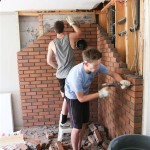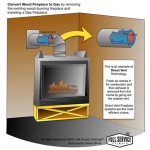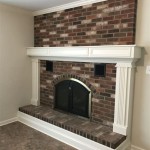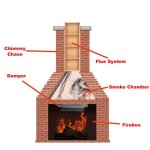How Much Does It Cost To Replace A Fireplace And Chimney?
Replacing a fireplace and chimney is a significant home improvement project with costs that can vary widely depending on several factors. These factors include the type of fireplace, the extent of chimney damage or required modifications, local labor rates, material choices, and any necessary permits or inspections. Understanding the potential expenses involved is crucial for homeowners planning this type of renovation. This article will explore the various components of the cost, providing a comprehensive overview to help you budget effectively and make informed decisions.
The expenses associated with replacing a fireplace and chimney can be broadly categorized into the following areas: fireplace unit cost, chimney repair or replacement costs, installation labor, materials (including venting, flue liners, and masonry), permits and inspections, and potential additional costs related to demolition, structural modifications, or aesthetic upgrades.
Factors Influencing Fireplace Unit Cost
The type of fireplace selected directly impacts the overall cost of the project. Fireplaces are available in various fuel types, each with its own price range. Wood-burning fireplaces are generally the most affordable option in terms of the unit itself, but they may require more extensive chimney work for proper venting. Gas fireplaces offer convenience and efficiency, but the units tend to be pricier due to the integrated gas valve and burner assembly. Electric fireplaces are the simplest to install and often the least expensive upfront, but they provide primarily aesthetic value rather than a substantial heat source.
Beyond fuel type, the model and features of the fireplace also influence the price. A basic, builder-grade wood-burning fireplace will cost significantly less than a high-efficiency, zero-clearance gas fireplace with remote control and decorative features. Features such as variable flame height, thermostat control, and blower fans add to the cost. Similarly, the size of the fireplace and its BTU output will affect the price, with larger, more powerful units commanding a higher premium. Choosing a unit that is appropriately sized for the space you intend to heat is essential to avoid overspending.
Furthermore, the aesthetic design of the fireplace contributes to the cost. Simple, utilitarian designs are typically more budget-friendly, while elaborate models with intricate mantels, custom surrounds, and detailed fireboxes can significantly increase the price. Factors such as the material used for the firebox (e.g., firebrick, stainless steel) and the finish on the exterior (e.g., painted steel, cast iron) also play a role in determining the final cost of the fireplace unit itself.
Chimney Repair or Replacement Costs
The condition of the existing chimney is a critical factor in determining the overall cost of the project. If the chimney is in good repair and meets current safety standards, it may only require minor modifications to accommodate the new fireplace. However, if the chimney is damaged, deteriorated, or incompatible with the new fireplace, it may require extensive repairs or even complete replacement.
Common chimney problems that necessitate repair or replacement include cracked or spalling bricks, deteriorated mortar joints, a damaged or missing chimney cap, and a collapsed or blocked flue liner. Water penetration is a primary cause of chimney damage, as it can freeze and thaw within the masonry, causing it to crack and crumble. Regular chimney inspections are essential to identify and address potential problems before they escalate into costly repairs.
The cost of chimney repairs can vary widely depending on the extent of the damage. Minor repairs, such as repointing mortar joints or replacing a chimney cap, may cost a few hundred dollars. More extensive repairs, such as rebuilding a portion of the chimney or relining the flue, can cost several thousand dollars. In some cases, it may be more cost-effective to replace the entire chimney rather than attempting to repair it, especially if the chimney is severely damaged or nearing the end of its lifespan.
Chimney replacement entails demolishing the existing chimney and constructing a new one. The cost of chimney replacement depends on the height of the chimney, the materials used (e.g., brick, stone, prefabricated metal), and the complexity of the construction. A simple, brick chimney replacement may cost several thousand dollars, while a more elaborate stone chimney replacement can easily exceed ten thousand dollars. Prefabricated metal chimneys are often a more cost-effective alternative to masonry chimneys, especially for gas fireplaces, as they are lighter and easier to install.
Installation Labor, Materials, and Permits
Installation labor represents a significant portion of the overall cost of replacing a fireplace and chimney. The complexity of the installation will influence the labor costs, with more challenging installations requiring more time and expertise. Factors such as the location of the fireplace (e.g., interior wall, exterior wall), the accessibility of the chimney, and the need for any structural modifications will affect the labor rates.
The materials required for the installation include venting components, flue liners, masonry materials (if applicable), and finishing materials. The cost of these materials will depend on the type of fireplace and chimney, as well as the quality and aesthetic appeal of the chosen materials. For example, stainless steel flue liners are more durable and expensive than aluminum flue liners. Similarly, high-quality bricks and mortar will cost more than standard materials.
Permits and inspections are essential for ensuring that the fireplace and chimney installation meets local building codes and safety standards. The cost of permits varies depending on the municipality and the scope of the project. Inspections are typically required at various stages of the installation process to verify that the work is being performed correctly. Failing to obtain the necessary permits and inspections can result in fines and delays, and it can also jeopardize the safety of your home.
In addition to the core installation costs, there may be additional expenses related to demolition, structural modifications, or aesthetic upgrades. Demolishing the existing fireplace and chimney can add to the cost, especially if the structure contains asbestos or other hazardous materials that require special handling. Structural modifications may be necessary to accommodate the new fireplace or chimney, such as reinforcing the hearth or modifying the framing. Aesthetic upgrades, such as adding a new mantel, surround, or hearth, can also increase the overall cost of the project.
When estimating the cost of replacing a fireplace and chimney, it is crucial to obtain multiple quotes from qualified contractors. Be sure to ask for a detailed breakdown of the costs, including the cost of the fireplace unit, chimney repairs or replacement, installation labor, materials, permits, and any potential additional expenses. Comparing quotes from different contractors will help you identify the most competitive price and ensure that you are getting a fair deal.
It is also essential to check the contractor's credentials and ensure that they are licensed and insured. A licensed contractor has met the necessary qualifications and has demonstrated competence in their field. Insurance protects you from liability in case of accidents or damages during the installation process. Checking references from previous customers can also provide valuable insights into the contractor's quality of work and customer service.
Furthermore, consider the long-term costs of owning and operating the new fireplace. Wood-burning fireplaces require regular maintenance, such as chimney cleaning and ash removal. Gas fireplaces require periodic servicing to ensure proper functioning and safety. Electric fireplaces have minimal maintenance requirements, but they may have higher operating costs due to electricity consumption. Weighing the long-term costs against the upfront investment will help you make an informed decision about the type of fireplace that is best suited for your needs and budget.
Finally, remember to factor in a contingency fund for unexpected expenses. Even with careful planning, unforeseen problems can arise during the installation process, such as hidden damage to the chimney or unexpected structural issues. Having a contingency fund of 10-15% of the total project cost can help you cover these unexpected expenses and avoid delays or budget overruns.
Replacing a fireplace and chimney is a complex project that requires careful planning and budgeting. By understanding the various factors that influence the cost, you can make informed decisions and effectively manage your expenses. Obtaining multiple quotes from qualified contractors, checking their credentials, and factoring in long-term costs and a contingency fund will help ensure a successful and cost-effective renovation.

How Much Does Chimney Replacement Cost In 2024 Forbes Home

How Much Does Fireplace Removal Cost In 2024 Checkatrade

How Much Does Chimney Removal Cost

Fireplace Installation Cost 2024 Gas Wood Burning Electric

Fireplace Repair Cost To Fix Fixr

How Much Does It Cost To Put In A Fireplace Direct Fireplaces

Fireplace Vs Wood Stove Installation Costs Stamford Fireplaces

2024 Fireplace Chimney Removal Cost Stack T Demolition

How Much Does A Gas Fireplace Insert Cost Forbes Home

How Much Does A Fireplace Remodel Cost 2024 Data Angi
Related Posts








